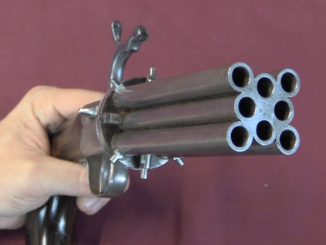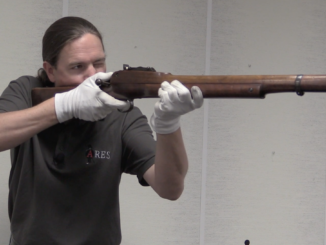The 1862 Police Pocket was the last of Colt’s percussion revolvers. It was a combination of the small 1849 model frame (intended for .31 caliber) and a 5-shot .36 caliber cylinder. The frame was stepped to allow the larger cylinder to fit without require any changes to the lockwork, and the result was a rather nice svelte revolver offering both reasonable firepower and relatively compact size. This particular one was exported to the UK at some point, as evidenced by its British proof marks, and also comes with the original case and accessories.
Related Articles

Revolver
Oversized 8-Barrel British Pepperbox Revolver
The typical pepperbox revolver is a sleek and small .31 caliber double action pocket gun, like the Allen & Thurber standard type. This one, however, is anything but typical. This London-made gun is a far […]

Bolt Action Rifles
Heavy But Effective: Britain’s No4 MkI (T) Sniper Rifle
RIA’s catalog page for this rifle The main British sniper rifle of World War Two, and arguably one of the best looking military sniper rifles of all time, the No4 MkI (T) was something the […]

Bolt Action Rifles
Thorneycroft: A Victorian Bullpup Rifle with Volley Sights
The Thorneycroft was the first military bullpup rifle, developed in the United Kingdom in response to combat experiences in the second Boer War showing the British infantry rifles to be overly long and cumbersome. Scotsman […]

I always wonder why revolvers are mainly six-shooters? For later models its may be easily explained by tradition, but what about the earliest one? Why they hold mainly 6 loads not say 5 or 7?
It’s a pure speculation, but 6 holes seems to be easier to calculate/draw with a compass rather than entering in more complex thing to calculate the right spacing.
(some old “repeatiters” muskets design had a 3-rotary-barrel design. Like pepperbox, but with carbine length)
By the way, if someone knows the true reason, I’m also interested.
Adams revolvers were the big sellers in the UK in the days of percussion revolvers, and they were also the official army revolvers. They mainly seemed to use a 5 round cylinder, although there were also 6 round models.
Adams held the rights to his revolver design, and they were manufactured by a number of companies in the UK. They were also made under license in the US for the US market.
I’d imagine it had to do with how many holes you could bore in a cylinder of convienient size that wouldn’t blow up due to the available materials of the time. After that, tradition does kind of come into play.
What Robert said is basically the reason. Also, overall bulk comes into it.
Early on, four-barreled flintlock pocket pistols were common. In the early to mid 1700s, five- and six-barreled flintlock pepperboxes came into fashion. (Some were even DA and self-priming, BION.) One peculiar type had seven barrels, one in the center; the sixth barrel firing flashed through a hole and fire no. 7 simultaneously.
When revolvers came along, they generally had the same number of chambers as pepperboxes had barrels just to keep the weight down, because lighter weight was one of the revolver’s main selling points over the pepperbox. Also, more chambers meant more precise indexing as the cylinder rotated, and the machining of the day really wasn’t up to it.
There were exceptions, like the LeMat (eight or nine chambers plus the center shot barrel) and freaks like the giant Aaron Vaughn two-barrel, 14-shot;
http://vignette4.wikia.nocookie.net/poopmeister/images/0/06/Vaughan_revolver.png/revision/latest?cb=20140221155943
(Yes, they really built the thing.)
But for reasons of practicality, five or six is generally the limit.
BTW, on compact S&W type revolvers in .357 Magnum or more emphatic calibers, five-shot cylinders are more durable than six-shot ones. The S&W cylinder geometry puts the cylinder lock recess right over the chamber on any cylinder with an even number of chambers; this can lead to dimpling of the chamber at that point with sustained use of high-power loads. An odd number of chambers puts the lock recesses in the “triangles” of solid metal between the chambers. Much less aggravation all around.
With Colt type cylinders, it’s the opposite; the recesses are offset on the even-numbered types, which probably explains why so few Colt designs ever had five-shot cylinders.
cheers
eon
“An odd number of chambers puts the lock recesses in the “triangles” of solid metal between the chambers.”
All very high-powered modern revolver, which I’m aware of have odd number of chambers:
S&W Model 460 firing .460 S&W has 5 chambers
Pfeifer Zeliska firing .600 Nitro Express has 5 chambers
Tula РШ-12 firing 12.7x55mm has 5 chambers (if you don’t know this revolver, you can see some photos here: http://army-news.ru/2014/06/shturmovoj-revolver-rsh-12-iz-tuly/ )
That RSh-12 looks really interesting. The supposed bullet design with a 7 gram (108 grains) lightweight bullet is especially interesting.
Yes, high power large bore revolvers typically have only five cylinders. It’s probably a cost issue more than anything else for something like .460 S&W. For even larger calibers a six shot cylinder would also be very large. There is also very little need for a six shots in these monster calibers, since they are designed primarily for hunting (well, the RSh-12 is not not, but apparently it was not adopted by the FSB).
I think EON may have it the wrong way around. The six shot Colt SAA, with the same mechanism as the percussion revolvers, has the bolt cut central to the chamber. Whereas the ‘modern’ S&W D.A. has the bolt offset slightly allowing the cut to be towards the thicker material section. I have seen a number of S.A. Colt chambers with the dreaded dimple. Possibly due to over-enthusiastic reloading! But never a Smith. An ODD number of chambers would be ideal for the Colt.
I can’t speak for the Colt D.A. not having one to hand to check, but they didn’t make a decent one until the New Service – ancestor of the Python – when they adopted features of continental revolver designs.
The bullet mold that had one round and one conical chamber was interesting, after conical bullets were available what was the advantage of round ball?
If I remember well what I read, round ball is lighter than conical one and get more speed.
I also read a testimony of a sporting shooter who prefers reload his Chamelot-Delvigne with round balls to have better accuracy for shooting at 20m.
(but we could also counter that argument saying a heavier bullet is less prone to be deflected by side wind…)
All things considered, round ball has better stopping power. In shooting percussion Colts, mostly with 1861 Navies(my favorite)I tried casting conicals out of an original ’62 Police mold, a 2nd. Generation Navy mold and Buffalo Bore(I think)conicals and never could get accuracy worth a darn. thereafter I stuck to Speer .375 RBs and 20 gr. of FFFg for my shooting. I came to the conclusion that were I carrying back in the day, i’d have mys Colts loaded iwth round ball, and use the combustible cartridge packets for a (relatively) quick reload; I made combustibles also.
The old timers preferred round ball also for emptying saddles, and wrote the best use of a conical was for cattle headshots.
As to the ’62 Police being the last Colt percussion design, there was an article in the Rampant colt a good many years ago that considered the ’62 Pocket Navy to actually be the final model, as it was gotten into production first after the Colt factory fire of 1864.
Oh, I couldn’t cast any .36 round balls about of that original ’62 Police mold because the orund cavity had been cherried out to a .44 size! Go figure…
https://www.docsteach.org//images/documents/6037260/orig_6037260_15360.jpg Strange device making a mouse trap from an old relolver